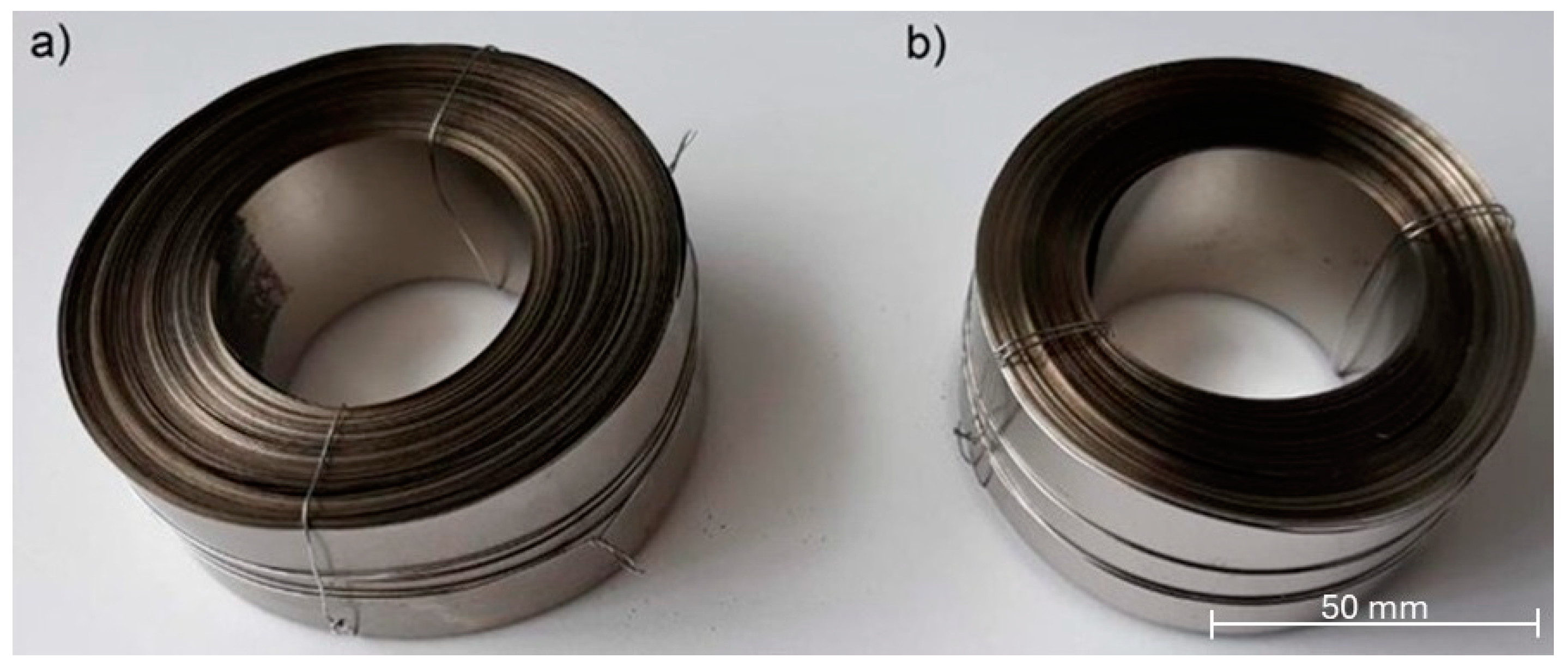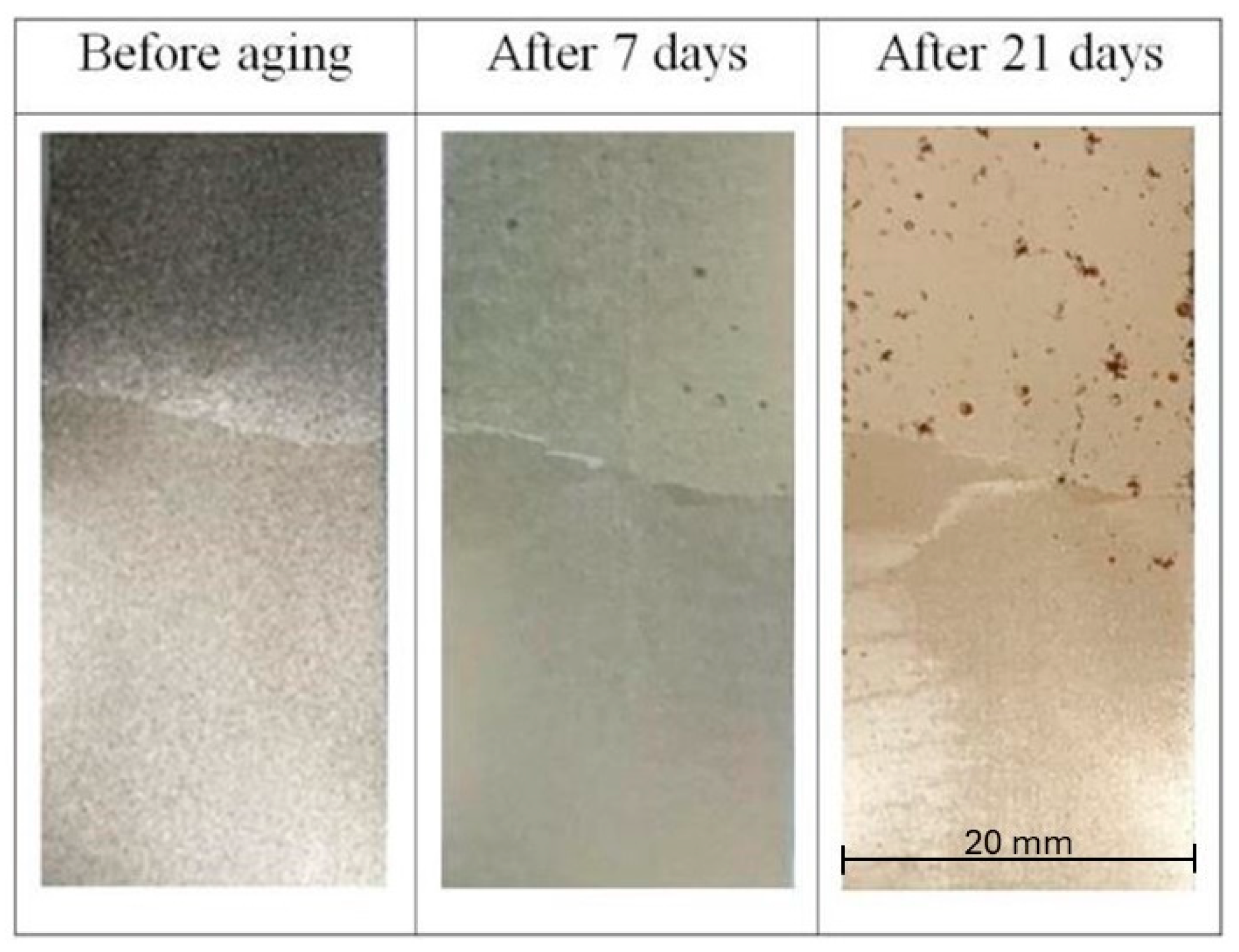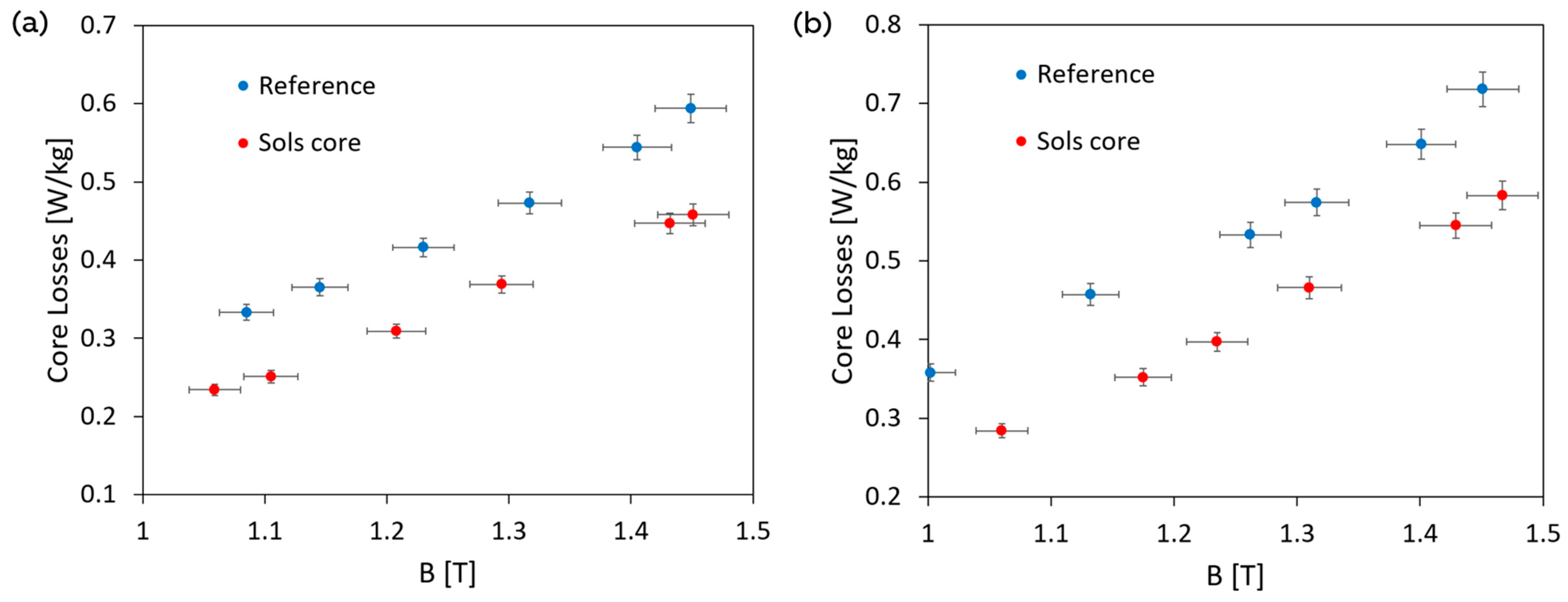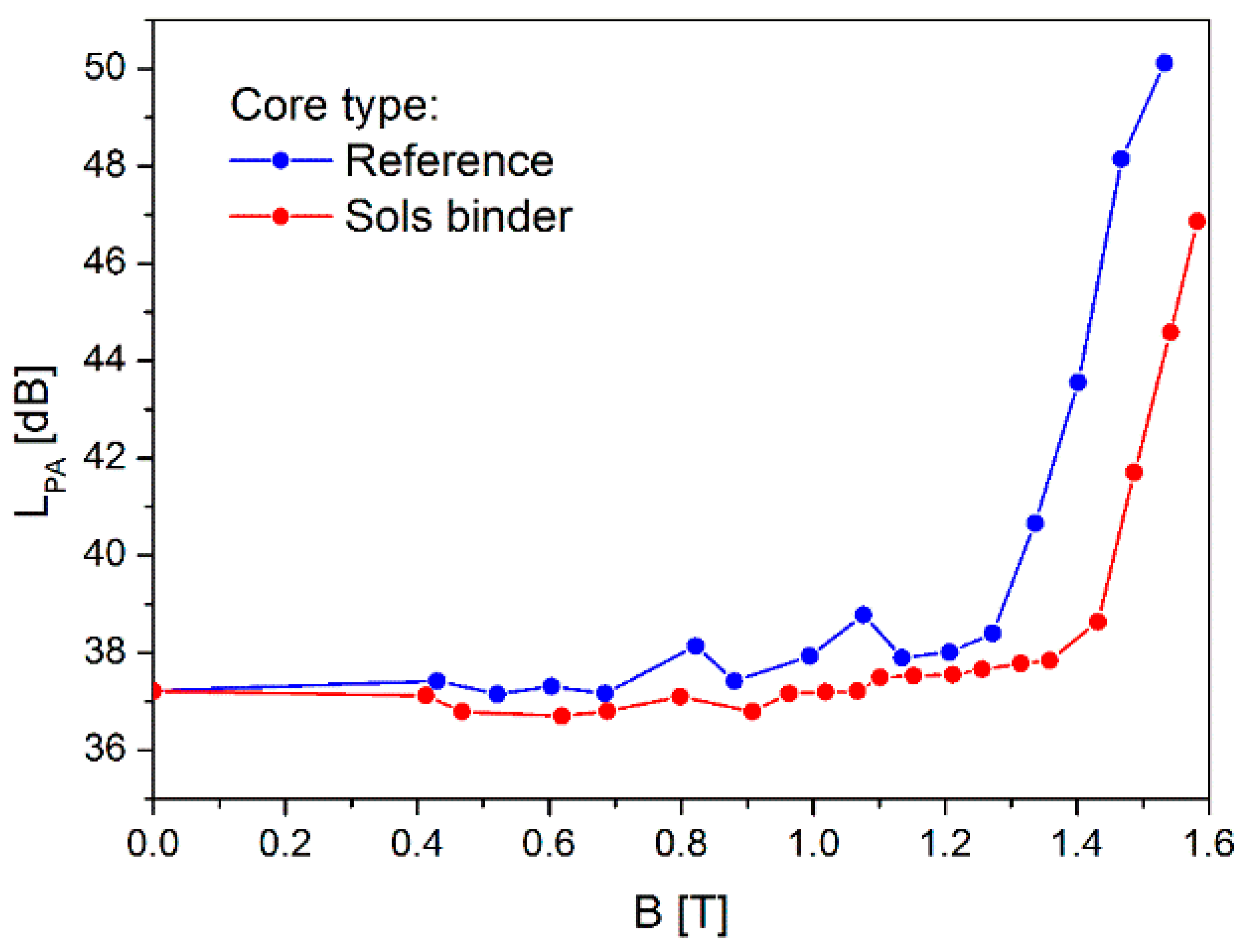Evaluation of Mechanical Stability, and Magnetic and Acoustic Properties of a Transformer Core Made of Amorphous Steel Consolidated with a Silane-Based Hybrid Binder
Abstract
Featured Application
Abstract
1. Introduction
2. Materials and Methods
2.1. Amorphous Metal Ribbon
2.2. Preparation and Application of Sol Binders on Amorphous Steel Ribbon
2.3. Corrosion Resistance
2.4. Dielectric Properties
- ε*(f)—complex permittivity [F/m],
- ε′(f)—real part of complex permittivity [F/m],
- ε″(f)—imaginary part of complex permittivity [F/m].
2.5. Model Toroidal Magnetic Core
2.6. Magnetic Measurements
- H(t)—magnetizing force [A/m],
- NH—number of turns,
- I(t)—current [A],
- lm—mean magnetic path length [m].
2.7. Noise Emission
3. Results
3.1. Corrosion Resistance
3.2. Dielectric Properties
- the effect of volumetric thermal expansion;
- the effect of temperature on polarizability [41].
3.3. Magnetic Properties
3.4. Noise Emission
4. Conclusions
Author Contributions
Funding
Institutional Review Board Statement
Informed Consent Statement
Data Availability Statement
Conflicts of Interest
Abbreviations
| TEOS | tetraethyl orthosilicate |
| BTSE | 1,2-bis(triethoxysilyl)ethane |
| CTE | coefficient of thermal expansion |
| AC | alternating current |
References
- Du, J.; Rasool, Y.; Kashif, U. Asymmetric Impacts of Environmental Policy, Financial, and Trade Globalization on Ecological Footprints: Insights from G9 Industrial Nations. Sustainability 2025, 17, 1568. [Google Scholar] [CrossRef]
- Borowski, P.F. Economic and Technological Challenges in Zero-Emission Strategies for Energy Companies. Energies 2025, 18, 898. [Google Scholar] [CrossRef]
- Chen, M.; Yu, Y.J.; Xiao, L.Y.; Wang, Q.L.; Chung, W.; Kim, K.; Baang, S. The Magnetic Properties of the Ferromagmetic Materials Used for HTS Transformers at 77K. IEEE Trans. Appl. Supercond. 2003, 13, 2313–2316. [Google Scholar] [CrossRef]
- Kurt, E.; Hatem, S. Design and Implementation of a MHz Frequency Transformer with a Ferromagnetic Fluid Core. Sustainability 2023, 15, 23. [Google Scholar] [CrossRef]
- Sima, W.; Liu, Y.; Sun, P.; Zhou, Y.; Peng, D.; Yang, M. The Effect of Different Core Materials on Transformer Inrush Currentsm. In Proceedings of the 2018 IEEE International Magnetics Conference (INTERMAG), Singapore, 23–27 April 2018. [Google Scholar]
- Heathcote, M.J. J&P Transformer Book, 12th ed.; Newnes: Oxford, UK, 1998; pp. 40–102+422–444. [Google Scholar]
- Molnar, A.; Smith, G.V.; Bartok, M. New Catalytic Materials from Amorphous Metal Alloys. Adv. Catal. 1989, 36, 329–383. [Google Scholar]
- McLyman, C.W.T. Transformer and Inductor Design Handbook, 4th ed.; CRC Press: Boca Raton, FL, USA, 2011; Volume 1, p. 11. [Google Scholar]
- Kronmuller, H.; Fahnle, M.; Domann, M.; Grimm, H.; Grimm, R.; Groger, B. Magnetic properties of amorphous ferromagnetic alloys. J. Magn. Magn. Mater. 1979, 13, 53–70. [Google Scholar] [CrossRef]
- Ramanan, V.R.V.; Smith, C.H.; Fish, G.E. Metallic glasses in magnetic applications. Key Eng. Mater. 1987, 13–15, 849–861. [Google Scholar] [CrossRef]
- Azuma, D.; Hasegawa, R. Core Loss in Toroidal Cores Based on Fe-Based Amorphous Metglas 2605HB1 Alloy. IEEE Trans. Magn. 2011, 47, 3460–3462. [Google Scholar] [CrossRef]
- Sato, T.; Yamada, T. Improvement of core loss by chemical thinning in a thick amorphous alloy ribbon. IEEE Trans. Magn. 1972, 28, 2775–2777. [Google Scholar] [CrossRef]
- Distribution Goes Green. Available online: https://library.e.abb.com/public/4b6d4b3cfd353a88c1257a25002696a8/ABB%20Review%202-2012_72dpi.pdf (accessed on 14 February 2025).
- Ramanan, V.R.V.; Pasquale, M.; Bertotti, G. The influence of microstructure on power losses in Fe-B-Si metallic glasses. J. Magn. Magn. Mater. 1994, 133, 362–365. [Google Scholar] [CrossRef]
- Luborsky, F.; Becker, J.; McCary, R. Magnetic annealing of amorphous alloys. IEEE Trans. Magn. 1975, 11, 1644–1649. [Google Scholar] [CrossRef]
- Kmita, G.; Sekula, R.; Rybak, A.; Kozupa, M.; Klys, P. Method of Manufacturing an Amorphous Magnetic Core and Amorphous Magnetic Core. European Patent Application No. EP3035351B1, 20 February 2019. [Google Scholar]
- Grimes, F.H.; Krause, R.F. Methods of Consolidating a Magnetic Core. U.S. Patent Application No. US4615106A, 7 October 1986. [Google Scholar]
- Goldman, I.; Grant, T.W.; Grote, J.K.; Collins, R.L.; Houser, K. Edge Bonding for Amorphous Metal Transformer. U.S. Patent Application No. US6413351B1, 2 July 2002. [Google Scholar]
- Verbunt, J.P.M. Lamellar Magnetic Core Utilizing Low Viscosity Epoxy Adhesive. U.S. Patent Application No. US4713297A, 15 December 1987. [Google Scholar]
- Lupinski, J.H. Bonded Amorphous Metal Electromagnetic Components. U.S. Patent Application No. US4201837A, 6 May 1980. [Google Scholar]
- Columbus, M.R.; Brown, R.; Takahashi, K.; Hasegawa, R. Method of Reducing Audible Noise in Magnetic Cores and Magnetic Cores Having Reduced Audible Noise. U.S. Patent Application No. US8427272B1, 23 April 2013. [Google Scholar]
- Nieroda, J.; Kmita, G.; Kozupa, M.; Piela, S.; Rybak, A. The Use of Polyimide as a Bonding Material to Improve the Mechanical Stability, Magnetic and Acoustic Properties of the Transformer Core Based on Amorphous Steel. Polymers 2024, 16, 1840. [Google Scholar] [CrossRef]
- Nieroda, J.; Rybak, A.; Kmita, G.; Niziol, J.; Gondek, E.; Sitarz, M. Synthesis and characterization of silane based binder for the amorphous metal ribbon. Thin Solid Film. 2020, 716, 138433. [Google Scholar] [CrossRef]
- Dral, A.P.; Tempelman, K.; Kappert, E.J.; Winnubst, L.; Benes, N.E.; ten Elshofa, J.E. Long-term flexibility-based structural evolution and condensation in microporous organosilica membranes for gas separation. J. Mater. Chem. A. 2017, 5, 1268–1281. [Google Scholar] [CrossRef]
- Nitta, S.V.; Pisupatti, V.; Jain, A.; Wayner Jr, P.C.; Gill, W.N.; Plawsky, J.L. Surface modified spin-on xerogel films as interlayer dielectrics. J. Vac. Sci. Technol. B 1999, 14, 205–212. [Google Scholar] [CrossRef]
- Zhao, J.H.; Ryan, T.; Ho, P.S.; McKerrow, A.J.; Shih, W.Y. Measurement of elastic modulus, Poisson ratio, and coefficient of thermal expansion of on-wafer submicron films. J. Appl. Phys. 1999, 85, 6421–6424. [Google Scholar] [CrossRef]
- Dalmoroa, V.; dos Santos, J.H.Z.; Armelin, E.; Aleman, C.; Azambuja, D.S. A synergistic combination of tetraethylorthosilicate and multiphosphonic acid offers excellent corrosion protection to AA1100 aluminum alloy. Appl. Surf. Sci. 2013, 273, 758–768. [Google Scholar] [CrossRef]
- Ramezanzadeh, B.; Raeisi, E.; Mahdavian, M. Studying various mixtures of 3-aminopropyltriethoxysilane (APS) and tetraethylorthosilicate (TEOS)silanes on the corrosion resistance of mild steel and adhesion properties of epoxy coating. Int. J. Adhes. Adhes. 2015, 63, 166–176. [Google Scholar] [CrossRef]
- Atanacio, A.J.; Latella, B.A.; Barbe, C.J.; Swain, M.V. Mechanical properties and adhesion characteristics of hybrid sol–gel thin films. Surf. Coat. Tech. 2005, 192, 354–364. [Google Scholar] [CrossRef]
- Khramov, A.N.; Balbyshev, V.N.; Kasten, L.S.; Mantz, R.A. Sol–gel coatings with phosphonate functionalities for surface modification of magnesium alloys. Thin Solid Film. 2006, 514, 174–181. [Google Scholar] [CrossRef]
- Batan, A.; Brusciotti, F.; De Graeve, I.; Vereecken, J.; Wenkin, M.; Piens, M.; Pireaux, J.; Reniers, F.; Terryn, H. Comparison between wet deposition and plasma deposition of silane coatings on aluminium. Prog. Org. Coat. 2010, 69, 126–132. [Google Scholar] [CrossRef]
- Ciobotaru, I.A.; Vaireanu, D.I.; Ciobotaru, I.E.; Barbu, O.C. The Influence of the Curing Temperature on the Properties of Some Silane Films. Rev. Chim-Buchar. 2017, 78, 1413–1418. [Google Scholar] [CrossRef]
- Nieroda, J.; Mastalska-Poplawska, J.; Rybak, A.; Sitarz, M. Spectroscopic and rheological investigation of candidates for the double-layered binder for amorphous metal ribbon. J. Mol. Struct. 2020, 1207, 127763. [Google Scholar] [CrossRef]
- Farad, M.A. Catalysts and the structure of SiO2 sol-gel films. J. Mater. Sci. 2000, 35, 1835–1841. [Google Scholar] [CrossRef]
- Franquest, A.; Biesemans, M.; Willem, R.; Terryn, H.; Vereecken, J. Multinuclear 1D- and 2D-NMR study of the hydrolysis and condensation of bis-1,2-(trie triethoxysilyl) ethane. J. Adhes. Sci. Technol. 2004, 18, 765–778. [Google Scholar] [CrossRef]
- Van Schaftinghen, T.; Le Pena, C.; Terryn, H.; Horzenberger, F. Investigation of the barrier properties of silanes on cold rolled steel. Electrochim. Acta 2004, 49, 2997–3004. [Google Scholar] [CrossRef]
- Mahmoudi, C.H.; Hassanzadeh, A.; Golzan, M.M.; Sedgh, H.; Talebian, M. Frequency dependence of ultrahigh dielectric constant of novel synthesized SnO2 nanoparticles thick films. Curr. Appl. Phys. 2011, 11, 409–413. [Google Scholar] [CrossRef]
- Venkataraman, B.H.; Varma, K.B.R. Frequency-dependent dielectric characteristics of ferroelectric SrBi2Nb2O9 ceramics. Solid State Ion. 2004, 167, 197–202. [Google Scholar] [CrossRef]
- Kremer, F.; Schönhals, A. Broadband Dielectric Spectroscopy; Springer: Berlin/Heidelberg, Germany; New York, NY, USA, 2003; pp. 188–199. [Google Scholar]
- Alias, R. Ceramic Substrate with Varied Sintering Temperatures, in Sintering Applications. In Structural and Dielectric Properties of Glass; Ertung, B., Ed.; IntechOpen: Rijeka, Croatia, 2013; pp. 89–118. [Google Scholar]
- Havinga, E.E. The temperature dependence of dielectric constants. J. Phys. Chem. Solids 1961, 18, 253–255. [Google Scholar] [CrossRef]






Disclaimer/Publisher’s Note: The statements, opinions and data contained in all publications are solely those of the individual author(s) and contributor(s) and not of MDPI and/or the editor(s). MDPI and/or the editor(s) disclaim responsibility for any injury to people or property resulting from any ideas, methods, instructions or products referred to in the content. |
© 2025 by the authors. Licensee MDPI, Basel, Switzerland. This article is an open access article distributed under the terms and conditions of the Creative Commons Attribution (CC BY) license (https://creativecommons.org/licenses/by/4.0/).
Share and Cite
Nieroda, J.; Kmita, G.; Kozupa, M.; Piela, S.; Sitarz, M.; Rybak, A. Evaluation of Mechanical Stability, and Magnetic and Acoustic Properties of a Transformer Core Made of Amorphous Steel Consolidated with a Silane-Based Hybrid Binder. Appl. Sci. 2025, 15, 5141. https://doi.org/10.3390/app15095141
Nieroda J, Kmita G, Kozupa M, Piela S, Sitarz M, Rybak A. Evaluation of Mechanical Stability, and Magnetic and Acoustic Properties of a Transformer Core Made of Amorphous Steel Consolidated with a Silane-Based Hybrid Binder. Applied Sciences. 2025; 15(9):5141. https://doi.org/10.3390/app15095141
Chicago/Turabian StyleNieroda, Jolanta, Grzegorz Kmita, Michal Kozupa, Szymon Piela, Maciej Sitarz, and Andrzej Rybak. 2025. "Evaluation of Mechanical Stability, and Magnetic and Acoustic Properties of a Transformer Core Made of Amorphous Steel Consolidated with a Silane-Based Hybrid Binder" Applied Sciences 15, no. 9: 5141. https://doi.org/10.3390/app15095141
APA StyleNieroda, J., Kmita, G., Kozupa, M., Piela, S., Sitarz, M., & Rybak, A. (2025). Evaluation of Mechanical Stability, and Magnetic and Acoustic Properties of a Transformer Core Made of Amorphous Steel Consolidated with a Silane-Based Hybrid Binder. Applied Sciences, 15(9), 5141. https://doi.org/10.3390/app15095141









